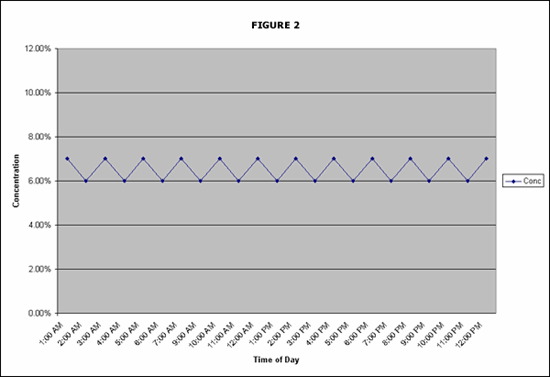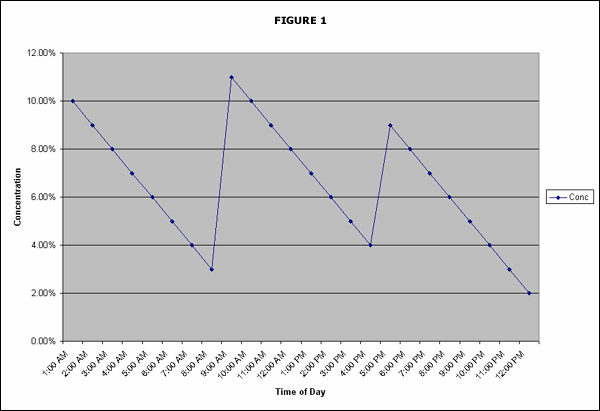Better Bath Management with Meter Controls
All electroplating, anodizing and electrocoating baths require maintenance. One of the most frequent needs is replenishing depleted materials. There are several techniques to accomplish that…
#management
It has been and continues to be common in the finishing industry to manually add brighteners, plating solution, acid, caustic, pigment, resin and other materials based on existing conditions, educated guesses or test-and-add methods. This can vary from measured amounts at prescribed times to a five-gal bucket-full whenever someone thinks of it. Some of the obvious disadvantages include the following:
- Forgetting to add the materials;
- Adding the wrong amounts;
- Adding the wrong materials;
- Peaks and valleys in bath chemistry because of inconsistent additions;
- Adding too much material, resulting in scrap, rework and wasted material;
- Adding too little material, resulting in scrap, rework and loss of business;
- Inability to certify the process;
- Difficulty in tracking process costs; and
-
Process control limits exceeding the specification limits.
Reducing Variation
Depleting bath chemicals occurs as a function of time, temperature and the number of items moving through the bath.
As you can see in Figure 1, if additions are made every 8 hr, the concentration of the bath varies significantly during the day. This illustration is based on the premise that the amounts added are correct. If the additions are made less frequently, then the effect is even more pronounced.
Featured Content
Compare the previous variation to Figure 2 where additions are made once per hour. It is obvious that the variation within the bath is much less. This variation can be improved even more with more frequent additions.
Measuring the correct parameter (time, amp-hr, conductivity, pH) that correlates with the rate of depletion and replenishing the bath at the corresponding rate will minimize process variation. This manifests itself in optimizing both costs and quality because expensive chemicals are not wasted, scrap and rework are reduced, and process predictability is enhanced.
Amp-Hr Basis for Additions
Using amp-hr to add materials is based on a direct correlation between the depletion rate and the amount of product going through the bath. This is true whether you are an electroplater, anodizer or electrocoater. The amp-hr measurement combines both time and current used and accommodates variances in load size as well as the time spent in the bath. The amp-hr meter constantly samples the amount of current used by the rectifier and generates an amp-hr measurement. The controller then sends a signal to the pumping system to add the required amount of material to the bath to replace the amount consumed. The length of time to pump and the frequency of additions can be adjusted to provide the precise amount needed. After these adjustments, an operator should find that the bath does not require testing as often because the chemistry remains more consistent throughout the day, week and month.
- The meter will have several inputs and outputs:
- Power (110 or 220 VAC);
- Millivolts from the rectifier amp meter or shunt;
- Pump outputs from relays in the meter;
- Alarm outputs from the meter; and
- Level inputs from the additive container.
Basic meters will show cumulative amp-hr totals. Optional features will make the meter a more valuable tool as well as making the operation less labor intensive and reliable. Options can include the following:
- Resettable amp-hr totals for load, shift, day or weekly tracking. This feature will allow you to track and trend productivity and compare different operators, shifts, bath chemistries or other factors.
- Non-resettable amp-hr totals. This feature is necessary to meet environmental compliance laws and regulations.
- Multiple pump operation. This feature allows you add two or more components to a bath at different rates based on the same rectifier and bath outputs.
- Multiple rectifier summing. This allows you to sum the amp-hr totals from one bath with multiple rectifiers so the additions can be based on the aggregate total.
- The capacity to add up pump cycles and pump run time. This allows you to track the amount of material added to the bath, use this data for performance trends and generate precise cost data as a function of amp-hr, run time or product.
- Permanent memory retention without the use of batteries. This feature is essential to maintain the integrity of data.
- Material level alarms. This provides warning before the reservoir is empty so that bath chemistries remain in tolerance.
- Fused pump outputs. These protect the meter in the event that a pump motor fails.
- PC network capability. This feature allows the user to access all of the data in the meter from a personal computer or PLC, download the data directly and integrate into spreadsheets and reports. It also allows the user to change meter settings and prevent tampering with the meter.
- Hand-held computer infrared data access. This is a different method of downloading data directly from the meter or changing parameters with the use of a hand-held computer.
- Integral pumps and controllers. This type of unit is very popular since it contains all of the components necessary to "plug and play." They come with one or two pumps and simplify the maintenance and installation of a system.
Not all meters will have these features or options. Should you need any or all of them, they may save you a considerable amount of time, money and effort compared to a less versatile product.
Time Basis for Additions
Some processes, such as cleaning or electroless processes, deplete materials proportionate to the length of time an item spends in the bath. In this situation, an operator would benefit from a time-based controller. These units can replenish either with fixed additions every time a rack enters the bath or as a function of the total number of minutes that accumulate while parts are in the bath. When a rack is placed in the bath, it trips a limit switch, activating these units.
Most of the same features and benefits described for amp-hr based additions pertain to time-based additions.
Conductivity or pH Basis for Additions
This approach affects not only the direct processes involved in plating, anodizing or electrocoating, but also ancillary processes such as off-line generation or waste treatment, since many of these have portions of the process that are controlled by or sensitive to either pH or conductivity.
In these applications the process in question can either be 1) Monitored with alarm outputs for out-of-tolerance conditions; or 2) Controlled with pump outputs.
In the latter case, the meter will constantly track the process parameter selected and when either a high or low level is reached, activate a pump to add the necessary material to bring the process back within tolerance. The more sophisticated meters will track the rate of change and add material at a variable rate to achieve process limits.
As before, the benefits of automated control and the meter features will be very similar. Additional considerations include temperature compensation to maintain measurement accuracy and the ability of the meter to accommodate the range that you need to measure.
Benefits of Automated Control
- Consistent bath chemistry;
- Reduced scrap and rework;
- Reduced costs;
- Increased productivity;
- Accurate process costs;
- Process control;
- Process certification; and
- Ability to sell to more demanding customers;
Many of these benefits provide significant tangible rewards in the form of increased profits as well as the intangible benefits of increased peace of mind knowing that these critical process parameters are under control. As with any piece of equipment, periodic checks to ascertain that reservoirs are full, tubes are clear and power is still available.
Additional Meter Options
Ripple Meters. These units measure the rectifier output and express their readings as a percentage AC of DC voltage. This is significant for a number of reasons:
- Process susceptibility. This is important if you are operating a process that is vulnerable to high ripple such as electrocoat, bright chrome or nickel. Rectifier components may fail or degrade while the rectifier is still capable of providing output. Consequently your process may produce unsatisfactory parts without warning and without an immediately visible cause.
- Rectifier failure. Your rectifier may experience partial failure or component degradation that will ultimate lead to complete rectifier failure. The ability to sense this before a catastrophic failure occurs can reduce repair costs, unscheduled downtime and loss of production.
- Power consumption. A rectifier operating with a defective component creates high ripple that also means that the rectifier is operating inefficiently, so your power bills are higher to produce the same amount of work.
Additional features to consider for this specific product include auto-ranging so that all voltages can be measured and alarm outputs set at adjustable settings.
Flow Meters. These units can both monitor and control the flow of material within the process. They can balance levels in baths, make additions based on the amount of material passing the measurement point and provide summary data and alarm outputs to assure process control.
Current Density Meters. The ability to measure current density is an invaluable tool to determine if you are optimizing ion transfer within your bath. By measuring the current density over the entire surface of part racks, you can assess anode placement, anode to cathode ratios, bath efficiency and deposition rates.
Meter Selection
Determining which brand and model of meter fits your needs should be based on several factors, including but not limited to ease of use, reliability, visibility of display, 110 or 220 VAC input, resistance to harsh environments, size and convenience of mounting and value. Of course, another critical factor is in choosing a vendor who knows your process and can supply reliable products.
RELATED CONTENT
-
Choosing and Troubleshooting Copper Electroplating Processes
Learn more on this inexpensive and highly efficient process.
-
Copper Plating on Aluminum and Aluminum Alloys
How can I plate copper on aluminum?
-
Zinc Electroplating
Choosing the best process for your operation.




















